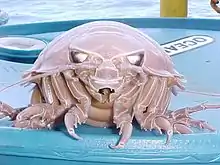Bathynomus giganteus
Bathynomus giganteus is a species of aquatic crustacean, of the order Isopoda. It is a member of the giant isopods (Bathynomus), and it is related—albeit distantly—to shrimps and crabs.[1]
| Bathynomus giganteus | |
|---|---|
 | |
| Scientific classification | |
| Kingdom: | Animalia |
| Phylum: | Arthropoda |
| Subphylum: | Crustacea |
| Class: | Malacostraca |
| Superorder: | Peracarida |
| Order: | Isopoda |
| Family: | Cirolanidae |
| Genus: | Bathynomus |
| Species: | B. giganteus |
| Binomial name | |
| Bathynomus giganteus A. Milne-Edwards, 1879 | |
It is abundant in cold waters and a depth of 310–2,140 m (1,020–7,020 ft) in the West Atlantic, including the Gulf of Mexico and Caribbean. It was the first species of Bathynomus to be described and historically it was reported from other oceans, but these are now recognized as other closely related species.[2][3] The unusually large size of Bathynomus has been attributed to an effect called deep-sea gigantism, where invertebrates living in cold deep waters tend to grow larger and have longer lifespans.[4][5]
They reproduce by laying eggs. Mature females develop a pouch known as a marsupium, where the eggs are stored until the young are ready to emerge as miniatures of the adults, known as manca, completely bypassing a larval stage.[6]
Giant isopods are not usually fished commercially, although other species of Bathynomus can be found in the occasional oceanside restaurant in northern Taiwan, where they are boiled and served with rice.[1]

References
- "Giant Isopod | Bathynomus giganteus | SeaPics.com". seapics.com. Retrieved 17 January 2019.
- Lowry, J. K.; Dempsey, K. (2006). "The giant deep-sea scavenger genus Bathynomus (Crustacea, Isopoda, Cirolanidae) in the Indo-West Pacific". In Richer de Forges, B.; Justone, J.-L. (eds.). Tropical Deep-Sea Benthos. 24. Mémoires du Muséum national d’Histoire naturelle. pp. 163–193.
- Shipley, O.; Bruce, N.L.; Violich, M.; Baco, A.; Rawlins, S.; Brooks, E.J. (2016). "A new species of Bathynomus Milne Edwards, 1879 (Isopoda: Cirolanidae) from The Bahamas, Western Atlantic". Zootaxa. 4147 (1): 82–88.
- McClain, C.R. (4 April 2007). "Why is The Giant Isopod Giant? | ScienceBlogs". scienceblogs.com. Retrieved 17 January 2019.
- Timofeev, S.F. (November 2001). "Bergmann's Principle and Deep-Water Gigantism in Marine Crustaceans". Izvestiia Akademii nauk. Seriia biologicheskaia / Rossiiskaia akademiia nauk. 28 (6): 764–768.
- Ax, Peter (28 August 2000). Multicellular Animals: The Phylogenetic System of the Metazoa. Springer Science & Business Media. ISBN 9783540674061.